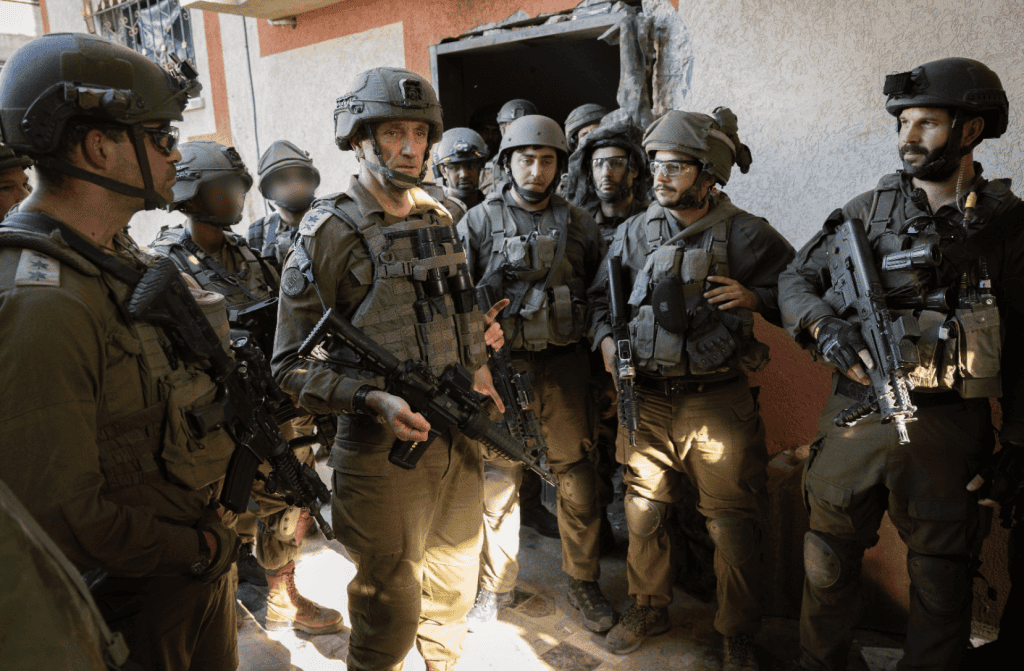
Photo: IDF Chief of the General Staff Herzi HaLevi with reserve soldiers in the Gaza Strip, November 21. (IDF)
Israel considered a ceasefire with Hamas on Tuesday evening, November 21. The multi-day ceasefire is mediated via Qatar and reportedly includes fifty or more hostages being freed in exchange for Israel releasing prisoners. Israel and Hamas have been at war since Hamas attacked Israel on October 7, killing 1,200 people in Israel. After three weeks of air strikes, Israel launched a ground operation in Gaza on October 27. The offensive has been ongoing for almost four weeks. Israel has lost 390 soldiers, including on October 7, and in the month and a half of fighting since then.
Israel continued to strike Hamas over the last day. The IDF said 250 targeted were struck between November 20 and 21. “Among the targets struck were dozens of terrorists, rocket launchers, and terrorist infrastructure,” the IDF said on Tuesday morning. These included a rocket launch site and other terror infrastructure. The IDF also found a “weapons stockpile” in a civilian home and uncovered an anti-tank missile hidden in a baby’s crib, the IDF said.
In the northern part of the Gaza Strip, the IDF’s 162nd Division pushed into Jabalya, a built-up area adjacent to Gaza City. Israel has struck terror targets here over the last month and a half. On November 21, the IDF destroyed three tunnels in this area. The IDF also said that troops “from the Nahal Brigade killed dozens of terrorists over the past few days with support of tanks and UAVs.” As in other areas, the IDF said they found weapons in private homes.
Israel Defense Minister Yoav Gallant, who visited northern Israel on Saturday, November 18, went to the headquarters of the Gaza division on November 21. He was able to observe IDF operations in Gaza through screens in an observation room, his office said in a statement. “Our forces are fighting on the frontline, and they are supported by [troops] in the Nahal Oz observation room, which is located in the division HQ.” The Nahal Oz observation room was moved to the Reim base, where the Gaza division headquarters is located, after the actual Nahal Oz observation post was overrun and damaged by Hamas on October 7. Although the post was retaken, several observation soldiers were killed and taken hostage. One of them was freed in late October, and the body of a second IDF observer soldier was found near Shifa Hospital on November 16. Gallant’s reference to the observation room came in the context of this background about the impact the war had on IDF observers, who are mostly female soldiers.
“Our troops are maneuvering deep inside [Gaza], they are doing excellent work. Their determination and precision, and the combination of ground, aerial, and naval forces working based on accurate intelligence, leads to extraordinary achievements. I commend the IDF, ISA, and all the security forces who are doing excellent work,” Gallant said on November 21. Gallant said the next decisions in Gaza would be difficult, referring to the possible hostage deal. “I am aware of the pain that the families are experiencing and I would like to tell you that for me – returning the hostages is a primary goal and I will do everything possible to achieve it,” he said.
IDF Chief of Staff Herzi Halevi also visited IDF soldiers on November 21. He went to meet with reservists who had been fighting in Beit Hanoun in northern Gaza. “The way ahead is still long. We must be determined to take this route and deliver maximum achievements, to dismantle Hamas militarily and governmentally, to establish improved security in the communities in the southern region, and to bring back the hostages,” Halevi said.
Focus on the ceasefire in Israel came as Hezbollah increased attacks in northern Israel. Hezbollah has increased attacks over the last several days, which appears to indicate a trend. On Tuesday, attacks began in the morning with anti-tank missile launches toward Metula, a border town in northern Israel. Later, the IDF said, “aircraft identified and struck three armed terrorist cells in the area of the border with Lebanon. In addition, IDF fighter jets struck a number of Hezbollah terror targets, including military infrastructure and structures used for directing terrorist activity.” Hezbollah fired mortars at Israel, and sirens sounded in Israel in communities near the northern border overlooking the Mediterranean Sea. The IDF said there was a drone or UAV infiltration and more anti-tank fire in the evening.
Lebanese pro-Iranian Al-Mayadeen media claimed two of its reporters were killed in an IDF strike in Lebanon. Israeli authorities didn’t comment on the incident. Other reports also said a deputy commander of Hamas in Lebanon was killed on Tuesday. These incidents, along with the Iran-backed Houthis hijacking a ship over the weekend in the Red Sea, have led to tensions on other fronts for Israel.







